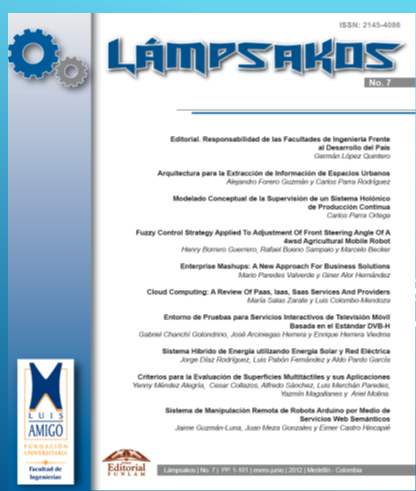Enterprise Mashups: A New Approach for Business Solutions
DOI:
https://doi.org/10.21501/21454086.843Palabras clave:
Enterprise Mashups, Web applications.Resumen
A mashup is a Web application that integrates content from different providers in order to create a new service which is not offered by the content provider. The development of this kind of applications involves activities such as accessing heterogeneous sources, combining data from different data sources and building graphical interfaces. This factor limits non-experienced computer users to develop these applications. However, nowadays there are enterpriseoriented tools that allow non-experienced user for building mashups in order to respond business needs in an easy and rapid way. Due to this, the enterprise mashup approach has been widely adopted by a large number of enterprises. This paper presents an overview of the enterprise mashup approach, as well as a review of four enterprise-oriented tools which provide a set of features that allows non-expertise users developing mashups into an enterprise. Finally, we present the challenges to be addressed by enterprise-oriented mashup tools in order to provide an easier and faster way of developing mashups.Descargas
Referencias
J. Magazinius, A. Askarov, A. Sabelfeld. “A Lattice-based Approach to Mashup Security”. Proceedings of the 5th ACM Symposium on Information, Computer and Communications Security, pp. 15-23, 2010.
O. Chudnovskyy, H. Gebhardt, F. Weinhold, M. Gaedke. “Business Process Integration using Telco Mashups”. The 8th International Conference on Mobile Web Information Systems, Vol. 3. pp. 677-680, 2011.
J. Soriano, D. Lizcano, M. Cañas, M. Reyes, J. Hierro. “Fostering Innovation in a Mashuporiented Enterprise 2.0 Collaboration Environment”. SIWN International Conference on Adaptive Business Systems, 2007.
Z. Maraikar, A. Lazovik, F. Arbab. “Building Mashups for the Enterprise with SABRE”. Proceedings of the 6th International Conference on Service-Oriented Computing, pp. 70-83, 2008.
J. López, F. Bellas, A. Pan, P. Montoto. “A Component-Based Approach for Engineering Enterprise Mashups”, Lecture Notes in Computer Science, Vol. 5648, pp. 30-44, 2009.
M. Altinel, P. Brown, S. Cline, R. Kartha, E. Louie, V. Markl, L. Mau, Y. Ng, D. Simmen, A. Singh. “Damia: A Data Mashup Fabric for Intranet Applications”. Proceedings of the 33rd international conference on Very large databases, pp. 1370-1373, 2007.
A. Huang, S. Huang, E. Lee, S. Yang, “Improving End-User Programming with Situational Mashups in Web 2.0 Environment”. Proceeding of the 2008 IEEE international Symposium on Service-Oriented System Engineering, pp. 62-67, 2008.
S. Abiteboul, O. Greenshpan, T. Milo, N. Polyzotis, “MatchUp: Autocompletion for Mashups”. Proceedings of the VLDB Endowment, Vol. 2 pp. 538-549, August 2009.
V. Hoyer, K. Stanoevska-Slabeva. “Towards a Reference Model or Grassroots Enterprise Mashup Environments”. Proceedings of the 17th European Conference on Information Systems, 2009.
L- Xu, P. Vrieze, K. Phalp, S. Jeary, P. Liang. “Lightweight Process Modeling for Virtual Enterprise Process Collaboration”. 11th IFIP Working Conference on Virtual Enterprises, pp. 501-508, October, 2010.
P. Vrieze, L. Xu, A. Bouguettaya, J. Yang, & J. Chen. “Process-oriented Enterprise Mashups”. Proceedings of the 2009 Workshops at the Grid and Pervasive Computing Conference, pp. 64- 71, 2009.
V. Hoyer, K. Stanoevska-Slabeva, “Design Principles of Enterprise Mashups”. Proceedings of the 5th Conference of Professional Knowledge Management, 2009.
A. MacAfee. “Enterprise 2.0 The Dawn of Emergent Collaboration”, MIT Sloan Managemente Review, April 2006. [14] Apatar, Retrieved from: http://apatar.com/, 2011.
IBM Mashup Center, Retrieved from http://www- 01.ibm.com/software/info/mashup-center/, 2011. [16] JackBe, Retrieved from: http://www.jackbe. com/, 2011. [17] WaveMaker, Retrieved
Descargas
Publicado
Cómo citar
Número
Sección
Licencia
De conformidad con las normas nacionales e internacionales sobre derechos de autor, las políticas de publicación de la Universidad Católica Luis Amigó y de la revista Lámpsakos (indexada con ISSN: 2145-4086), yo(nosotros), manifiesto(amos):
1. El deseo de participar como articulista(s) y someter a las normas editoriales establecidas por la revista (nombre la revista) el artículo titulado (nombre del artículo),
2. El compromiso de no retirar el artículo hasta no terminar el proceso de edición del número de la revista en curso.
3. Que el artículo es original e inédito y no ha sido postulado o presentado conjuntamente en otra(s) revista(s); por tanto, los derechos del artículo en cuestión no han sido cedidos con antelación y sobre ellos no pesa ningún gravamen ni limitación en su uso o utilización.
4. La inexistencia de conflicto de interés con institución o asociación comercial de cualquier índole.
5. Haber incorporado las citas y referencias de otros autores, tendientes a evitar el plagio. En consecuencia, afirmo que de ser publicado el artículo, no se violarán derechos de autor, de propiedad intelectual o de privacidad de terceros. Así mismo, de ser necesario, existe forma de evidenciar los permisos respectivos sobre derechos de autor originales para los aspectos o elementos extraídos de otros documentos como textos de más de 500 palabras, tablas, gráficas, entre otros. En caso de presentarse cualquier tipo de reclamación o acción por parte de un tercero en cuanto a los derechos de autor sobre el artículo, el(los) autor(es) asumirán toda la responsabilidad, y saldrán en defensa de los derechos aquí cedidos. Por tanto, para todos los efectos, la revista Lámpsakos de la Fundación Universitaria Luis Amigó actúa como un tercero de buena fe.
6. Que en el evento de publicarse el artículo, cedo(emos) a título gratuito y con carácter de exclusividad la integridad de los derechos patrimoniales así como los derechos de impresión, reimpresión y de reproducción por cualquier forma y medio, sin ninguna limitación en cuanto a territorio se refiere, en favor de la revista Lámpsakos de la Universidad Católica Luis Amigó.
7. Reconocer como coautores y/o colaboradores, a todos quienes participaron en ese rol y no se ha omitido a ninguno.








